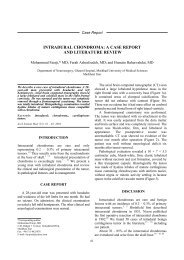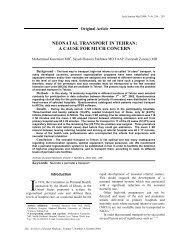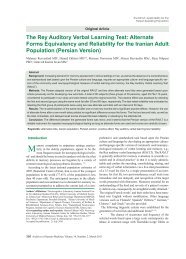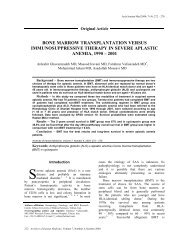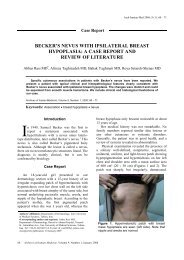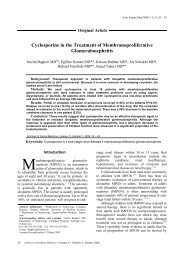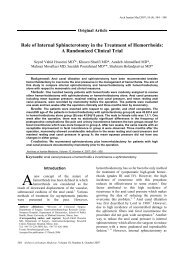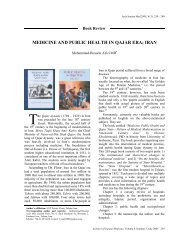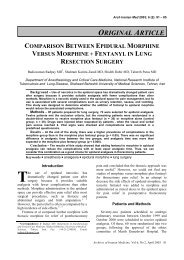SUCCESSFUL TREATMENT OF VITILIGO WITH PUNCH GRAFT ...
SUCCESSFUL TREATMENT OF VITILIGO WITH PUNCH GRAFT ...
SUCCESSFUL TREATMENT OF VITILIGO WITH PUNCH GRAFT ...
- No tags were found...
You also want an ePaper? Increase the reach of your titles
YUMPU automatically turns print PDFs into web optimized ePapers that Google loves.
Z. Hallaji, M. Daneshpazhooh, S. Rezai-KhiabanlooABFigure 1. Photograph of patient No. 8 showing a vitiligo lesion on the forehead (20 cm 2 ): A) beforegrafting; and B) 7 months after grafting, showing 90% repigmentation.8 On the other hand, PUVA, either systemic ortopical, increases the number of melanocytes andsynthesis of melanin. 1, 4, 5 Topical outdoor PUVA isa popular, practical and efficacious therapeuticoption for patients with limited vitiligo. 12 Themechanism of PUVA rests on the synergisticinteraction of the two components (8-methoxypsoralen and UVA light) in the skin. 13 Weconducted this study to evaluate the efficacy ofcombining punch grafting and topical outdoorPUVA in vitiligo patients.Patients and MethodsTwenty Iranian patients (12 women and 8 men,in the age renge of 13 – 40 years) with stablevitiligo underwent minigrafting in Razi Hospital,Tehran in 2000. The disease was segmental in four,focal in eight and generalized in eight cases. Allsubjects were otherwise healthy. They had beenresistant to systemic or topical methoxypsoralenand topical steroid therapies for at least 1 year.They showed neither spread of existing lesions nordevelopment of new lesions during the previous 6months. Patients under 12 years of age, pregnantand lactating women, and those with a history ofphotosensitivity or skin cancer were excluded fromthe study. After obtaining informed consent, onepatch was grafted in each patient without previousminigrafting test.The grafting site was prepared by infiltration of1% lidocaine without epinephrine followed byperforation of recipient holes of 1.5 mm deep and2.5 mm apart from each other. Minigrafts wereharvested from the gluteal region for the trunk andlimb regions, and the back of the ear for the facelesions; punches of 2 mm in size were placedwithin the recipient holes. Dressings were removed2 weeks later and all subjects observed twosessions per month for 3 months. Repigmentationrate was scored visually. Graft rejection wasdetermined as necrosis of the grafs in the recipientholes.All subjects applied 8-methoxypsoralen (0.1%alcoholic solution) and received sunlight for threesessions per week, for a maximum of 4 months.The first exposure time was 15 seconds and wasincreased by 10 seconds per session until theappearance of a slight erythema. Treatment wascontinued until complete repigmentation occurred,or for 4 months. If no evidence of repigmentationwas observed by this time, treatment wasdiscontinued and repigmentation was scored. Dataare presented as mean ± standard deviation.ResultsThree months after punch grafting, only nine(45%) patients experienced 33 – 66% repigmentation(partial repigmentation). The onset ofrepigmentation was between 28 and 45 days (35.3± 7.5). Further repigmentation stopped between 45and 75 days (61.7 ± 9.0). Four months after theinstitution of topical outdoor PUVA, 13 patientsexperienced 90 – 100% repigmentation (completeArchives of Iranian Medicine, Vol 6, No 2, April 2003 87



